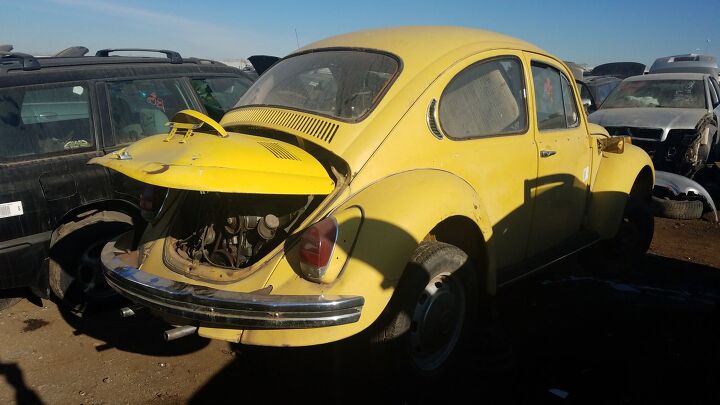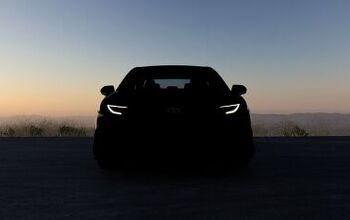QOTD: Bittersweet Beetle?

As you no doubt already know, we lost a big name this week. The Volkswagen Beetle — formerly the Volkswagen New Beetle, Volkswagen Beetle, Volkswagen Type 1, Volkswagen, KdF-Wagen, etc — finally bit the dust in Puebla, Mexico on Wednesday.
A mariachi band was on hand to provide the last production Beetle with an up-tempo swan song, Deutsche Welle reports. While it’s the end of the line for the historic, Hitler-tainted nameplate, memories remain. Do you have a personal encounter with this model you’d like to share?
Sad to say, your always humble author has no tales of cramped lewdness to recount for the class (fun fact: the plot of the Academy Award-winning 1960 film The Apartment begins when a VW Bug proves insufficiently spacious for the extramarital affairs of a middle-aged exec). Still, a Bug does show up in my cast of car characters.
The first manual transmission I ever rowed belonged to a ’72 Super Beetle owned by a co-worker, now father to my godsons. He’d park the yellow, 1600cc classic on the uphill side of the grocery store where we toiled away at night, allowing for an easy push start the following morning. Eventually, that VW boasted velvet-draped captain’s chairs and a fully wood paneled backseat/storage area.
While time has a way of watering down memories, there’s no erasing the feeling of vulnerability I experienced behind the wheel of that car. I have no idea how people motored around postwar America in those rolling deathtraps. (As I’ve stated before, the Bug’s unfamiliar handling characteristics propelled my father — following a near-disastrous 1968 test drive — into the nearest Ford dealership in search of a base Falcon. Now there’s a car you could set your watch to…).
As for the New Beetle and its slightly manlier successor, I never drove one. Never even got a lift from an owner. Never filled the flower vase or installed aftermarket eyelashes. Sad!
Of course, your tales might prove far more entertaining than this writer’s limited recollections. Is there a memorable Beetle experience in your past?
[Images: Murilee Martin/TTAC]

More by Steph Willems
Latest Car Reviews
Read moreLatest Product Reviews
Read moreRecent Comments
- SCE to AUX Range only matters if you need more of it - just like towing capacity in trucks.I have a short-range EV and still manage to put 1000 miles/month on it, because the car is perfectly suited to my use case.There is no such thing as one-size-fits all with vehicles.
- Doug brockman There will be many many people living in apartments without dedicated charging facilities in future who will need personal vehicles to get to work and school and for whom mass transit will be an annoying inconvenience
- Jeff Self driving cars are not ready for prime time.
- Lichtronamo Watch as the non-us based automakers shift more production to Mexico in the future.
- 28-Cars-Later " Electrek recently dug around in Tesla’s online parts catalog and found that the windshield costs a whopping $1,900 to replace.To be fair, that’s around what a Mercedes S-Class or Rivian windshield costs, but the Tesla’s glass is unique because of its shape. It’s also worth noting that most insurance plans have glass replacement options that can make the repair a low- or zero-cost issue. "Now I understand why my insurance is so high despite no claims for years and about 7,500 annual miles between three cars.



































Comments
Join the conversation
The Type 1 Beetles to avoid back in the days of my youth were the '68 through '70 models. VW engineering modified the alloy in the crankcase halves which "softened" the metal which, in turn, allowed the studs holding the heads on to loosen which cause head gasket leaks. The problem reared its ugly head around 40k miles or so. Helicoil made a killing on these. Late '70 on returned to a harder alloy. Also the valve heads for #3 cylinder tended to separate from the stems due to inadequate cooling (the air flow was poorer for this cylinder due to the ducting/fan layout) on many of these vehicles up until the latter '70s. But pulling the engine to fix these things was ridiculously easy (except for a couple of firewall nuts) and added to the owner experience.
You guys are pushing my nostalgia button. I had a 67 Beetle for about a year. Bought from a junkyard due to some of the interior being damaged by fire caused by the rear seat contacting the battery. VW had installed a cover, plastic on the 12V cars and tar paper lined metal on the 6V ones. These were often left off or improperly installed leading to short to ground for the battery + terminal and likely fire. Traded the 67 for a 68 VW van. Later got a wrecked 1970 Beetle that I made into a Baja bug. That went many thousands of miles across the deserts of the SW USA. Sold it in the early 80s. Around that time a customer offered his 1971 Beetle to me. At over ten years old it still looked like new. I rebuilt the motor that had been partially 'hot rodded'. It made 90 HP on an engine dyno. Does not sound like much, but a good running stock motor made 45 HP on the same dyno. A year or so after that a guy gave me a 1964 Beetle as he was moving to Hawaii. I completely rebuilt/restored that one. By the end of the 1980s I had sold both of them, but at one time I had 4 air cooled VWs. The '64 and '71 Beetle, a 1978 VW Campmobile, and a 1964 VW van. BTW the alloy of the engine case did not change for the '68 model year. What happened was the emission (smog) regulations. To meet the requirements the carburetor was changed and the engine ran leaner and hotter leading to the cylinder studs pulling out of the case. This happened on the earlier years also. Just took a little longer. For the 1971 Beetles (and vans) the engine got cooling system improvements. A larger fan and a better oil cooler. Also changes were made to the oil passages so more of the oil circulated through the cooler. Finally the 1972 models got better head studs that expanded more at the rate of the cylinders and heads.